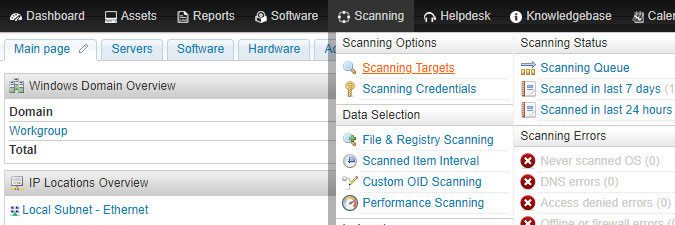

- #LANSWEEPER WMI ACCESS DENIED HOW TO#
- #LANSWEEPER WMI ACCESS DENIED UPDATE#
- #LANSWEEPER WMI ACCESS DENIED VERIFICATION#
- #LANSWEEPER WMI ACCESS DENIED CODE#
- #LANSWEEPER WMI ACCESS DENIED WINDOWS#
The RPC client MUST use an authentication level of RPC_C_AUTHN_LEVEL_PKT_PRIVACY (value = 6), as specified in section 2.2.1.1.8.
MS-TSCH: The RPC server MUST require RPC_C_AUTHN_GSS_NEGOTIATE or RPC_C_AUTHN_WINNT authorization.  MS-DCOM: The server SHOULD register one or more security providers specified in section 2.2.1.1.7 the choice of security provider is implementation-dependent. Unfortunately some others have less restrictive requirements: MS-LSAD: The requester MUST NOT use the RPC-provided security-support-provider mechanisms (for authentication, authorization, confidentiality, or tamper-resistance services). MS-SAMR: The server SHOULD reject calls that do not use an authentication level of either RPC_C_AUTHN_LEVEL_NONE or RPC_C_AUTHN_LEVEL_PKT_PRIVACY. Note again that the default is CONNECT, which means no integrity checking.įortunately, most protocols built on RPC have minimum security requirements (nicely documented in section 2.1 for each of Microsoft’s protocol documentations): Same as RPC_C_AUTHN_LEVEL_PKT_INTEGRITY but also ensures that the data transferred can only be seen unencrypted by the client and the server. Same as RPC_C_AUTHN_LEVEL_PKT but also verifies that none of the data transferred between the client and server has been modified. Same as RPC_C_AUTHN_LEVEL_CONNECT but also prevents replay attacks. The authentication level sets the presence or absence of authentication and integrity checks in the RPC exchange: NameĪuthenticates the credentials of the client and server. Note that the default is WINNT, which means NTLM authentication – sounds good.
MS-DCOM: The server SHOULD register one or more security providers specified in section 2.2.1.1.7 the choice of security provider is implementation-dependent. Unfortunately some others have less restrictive requirements: MS-LSAD: The requester MUST NOT use the RPC-provided security-support-provider mechanisms (for authentication, authorization, confidentiality, or tamper-resistance services). MS-SAMR: The server SHOULD reject calls that do not use an authentication level of either RPC_C_AUTHN_LEVEL_NONE or RPC_C_AUTHN_LEVEL_PKT_PRIVACY. Note again that the default is CONNECT, which means no integrity checking.įortunately, most protocols built on RPC have minimum security requirements (nicely documented in section 2.1 for each of Microsoft’s protocol documentations): Same as RPC_C_AUTHN_LEVEL_PKT_INTEGRITY but also ensures that the data transferred can only be seen unencrypted by the client and the server. Same as RPC_C_AUTHN_LEVEL_PKT but also verifies that none of the data transferred between the client and server has been modified. Same as RPC_C_AUTHN_LEVEL_CONNECT but also prevents replay attacks. The authentication level sets the presence or absence of authentication and integrity checks in the RPC exchange: NameĪuthenticates the credentials of the client and server. Note that the default is WINNT, which means NTLM authentication – sounds good. #LANSWEEPER WMI ACCESS DENIED WINDOWS#
Tools relying on RPC use the standard Windows Security Providers for authentication. Authentication and Integrity Security providers RPC is allowed through the Windows Firewall by default as it is used for remote management (among other things).
Monitoring and remote management tools support WMI (a quick search gives for example Solarwinds, NetCrunch, PRTG, LanSweeper, Kaseya, etc.) and must have a privileged service account configured. WMI bases on DCOM which uses RPC as a transport (sometimes over SMB): RPC is used for remote system management purposes. MSRPC (aka MS-RPCE) is Microsoft’s modified version of DCE/RPC. DCE/RPC is a protocol standard for RPC designed by the Open Group. A remote procedure call ( RPC) is when a program executes a procedure in a different address space (e.g.  SMB and more → LDAPS and more (Drop the MIC). These attacks relay the following protocols:
SMB and more → LDAPS and more (Drop the MIC). These attacks relay the following protocols: #LANSWEEPER WMI ACCESS DENIED HOW TO#
Drop the MIC – or how to bypass completely protection against relaying. PrivExchange – or how to escalate from any user having an Exchange mailbox to Domain Admins. The Printer Bug – a nice way to trigger SMB connections from Windows Server (particularly handy in combination with Unconstrained Delegation). NTLM relay has been used and reused in several attacks: This can be achieved using traditional spoofing techniques (ARP, DNS, LLMNR & Netbios, etc.) or by triggering a connection to the attacker machine through a bug or misused feature (Printer Bug, Juicy Potato, etc.). In the end, he can use the authenticated session as he sees fit.įor such an attack to work, one needs to be in a man-in-the-middle position. He extracts the NTLM authentication blobs from the client messages and puts them in modified messages to the server and vice versa. The attacker acts as a server to the client and as a client to the server. The diagram below gives a simplified view of NTLM relay attacks: It does not fix the lack of global integrity requirement for RPC. The solution implemented adds integrity requirement for the Task Scheduler Service. #LANSWEEPER WMI ACCESS DENIED UPDATE#
Microsoft released a fix as part of the Update Tuesday in May 2020. This vulnerability was discovered by Compass Security in January 2020, disclosed to Microsoft Security Response Center and assigned CVE-2020-1113 as identifier. This attack was tested against a fully patched Windows Server 2016 Domain Controller.
#LANSWEEPER WMI ACCESS DENIED CODE#
Provided the victim has administrative privileges on the target, the attacker can execute code on the remote target.
#LANSWEEPER WMI ACCESS DENIED VERIFICATION#
CVE- 2020-1113ĭue to the absence of global integrity verification requirements for the RPC protocol, a man-in-the-middle attacker can relay his victim’s NTLM authentication to a target of his choice over the RPC protocol. In this article, we propose adding support for the RPC protocol to the already great ntlmrelayx from impacket and explore the new ways of compromise that it offers. Since a few years, we – as pentesters – (and probably bad guys as well) make use of NTLM relaying a lot for privilege escalation in Windows networks.







 0 kommentar(er)
0 kommentar(er)
